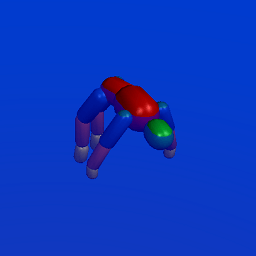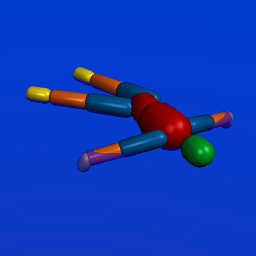Physical Water
The Physical Water is a cuboid shaped area inside which water interaction effects are simulated. The Physical Water is usually used with water objects: you can add the Physical Water node together with a Water node to indicate an area where physical interactions will take place. Note, however, that you cannot simulate waves by using the Physical Water.Physical Water是一个长方体形状的区域,在其中模拟水的相互作用效果.Physical Water通常用于水对象:您可以将Physical Water节点与Water节点一起添加以指示将发生物理交互的区域。但是请注意,您不能使用Physical Water模拟波。
Also it is possible to generate particles in the contacts between the Rigid bodies and the Physical Water (in order to create, for example, foam on the water or water splashes). This requires that the ObjectParticles node must be added as a child node to the Physical Water node.同样也可能在Rigid体和Physical Water之间的接触中生成粒子(例如在水或飞溅的水上产生泡沫)。这要求必须将ObjectParticles节点作为子节点添加到Physical Water节点。
Bodies with different physical properties behave differently in the same Physical Water. Therefore, in addition to editing Physical Water parameters, you should adjust parameters of the physical body in order to get the expected result.具有不同物理特性的实体在同一Physical Water中的行为不同。因此,除了编辑Physical Water参数,您应该调整身体的参数以获得预期结果。
Physical bodies of objects participating in the contact with a Physical Water can be obtained via code. Also you can get the depth of the object submergence, the force applied to the contact, coordinates of the contact point and the relative velocity between the object and the Physical Water.可以通过代码获得参与与Physical Water接触的对象的物理体。您还可以获得对象浸入的深度,施加到接触的力,接触点的坐标以及对象与Physical Water之间的相对速度。
By using the Physical Water, you can create, for example, flows in the ocean.通过使用Physical Water,您可以在海洋中创建流。
See also也可以看看#
- The PhysicalWater class to manage Physical Water nodes via APIPhysicalWater类,用于通过API管理Physical Water节点
-
A set of samples located in the data/samples/physicals folder:位于data/samples/physicals文件夹中的一组样本:
- water_00
- water_01
- The fragment from the video tutorial on physics demonstrating the Physical Water effect.来自的片段演示Physical Water效果的物理视频教程。
Adding Physical Water加水#
To add a Physical Water to the scene via UnigineEditor:通过UnigineEditor将Physical Water添加到场景中:
- Run the project with UnigineEditor.跑步UnigineEditor的项目。
-
On the Menu bar, click Create -> Water -> Physical Water.在菜单栏上,单击Create -> Water -> Physical Water。
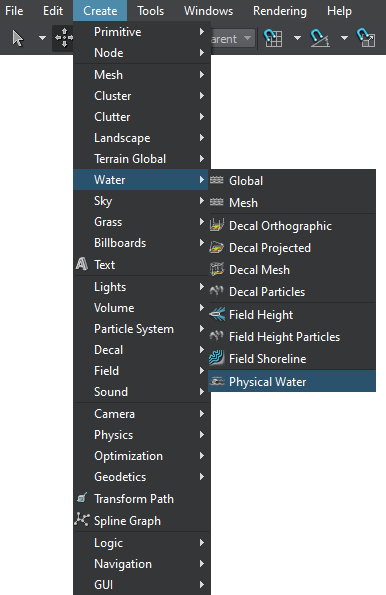
-
Click somewhere in the world to place the Physical Water.单击世界上的某个地方以放置Physical Water。
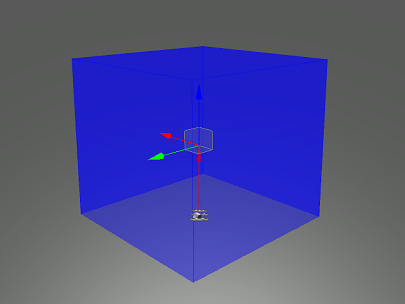
A new Physical Water node will be added to UnigineEditor, and you will be able to edit it via the Parameters window. By default, the size of the node is 1×1×1 unit.新的Physical Water节点将被添加到UnigineEditor,您将能够通过Parameters窗口对其进行编辑。默认情况下,节点的大小为1×1×1单位。
Editing Physical Water编辑物理水#
In the Physical Water section (Parameters window -> Node tab), you can adjust the following parameters of the Physical Water:在Physical Water部分(Parameters窗口→Node选项卡)中,可以调整Physical Water的以下参数:
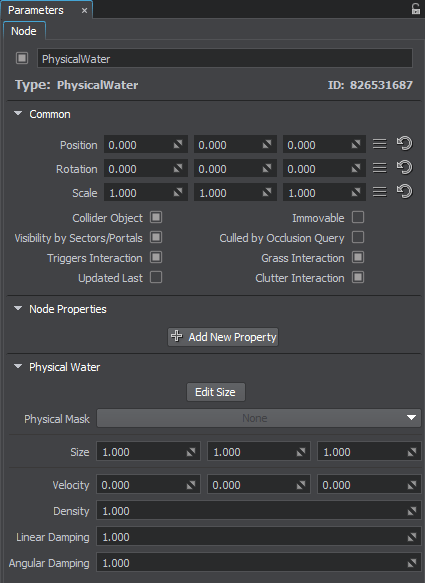
| Edit Size |
Toggles the editing mode for the Physical Water node. When enabled, the Physical Water box sides that can be resized are highlighted with the colored rectangles. To change the size of a side, drag the corresponding rectangle.切换Physical Water节点的编辑模式。启用后,可以调整大小的Physical Water框边会用彩色矩形突出显示。要更改边的大小,请拖动相应的矩形。
|
||||
|---|---|---|---|---|---|
| Physical Mask | Physical mask. The physical mask of the Physical Water must match the Physical mask of the physical object. Otherwise, the Physical Water won't affect the object.Physical掩码。 Physical Water的物理掩码必须比赛物理对象的Physical掩码。否则,Physical Water将不会影响该对象。 | ||||
| Size | Size of the Physical Water box along the axes in units.沿轴的Physical Water框的大小(单位)。 | ||||
| Velocity | Velocity of the flow in the Physical Water along the axes.沿轴在Physical Water中的流速。 | ||||
| Density |
Density of the Physical Water. It determines buoyancy of objects that float in the Physical Water. The higher the value, the higher is the buoyancy of the object. The lower the water density, the deeper the object submerges into water.Physical Water的密度。它确定漂浮在Physical Water中的对象的浮力。值越高,对象的浮力越高。水密度越低,物体浸入水中的深度就越大。 注意
|
||||
| Linear Damping | Value indicating how much the linear velocity of the objects decreases when they get into the Physical Water. The higher the value is, the lower the linear velocity will be.指示对象进入Physical Water时线速度降低多少的值。值越高,线速度将越低。 | ||||
| Angular Damping | Value indicating how much the angular velocity of the objects decreases when they get into the Physical Water. The higher the value is, the lower the angular velocity will be.指示对象进入Physical Water时角速度减小多少的值。值越高,角速度将越低。 |
本页面上的信息适用于 UNIGINE 2.19 SDK.


